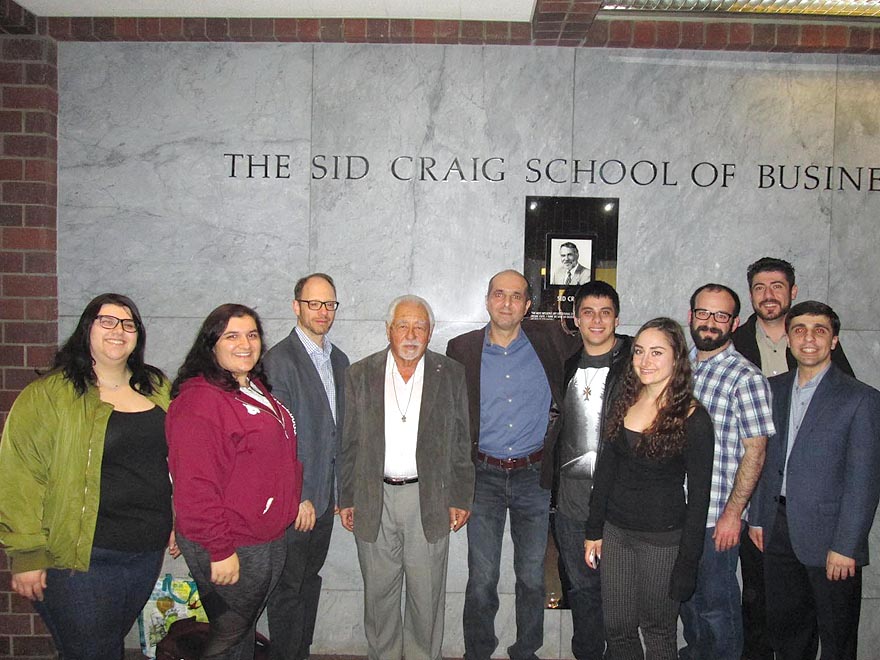
Michael Rettig
Editor
Kazan Visiting Professor in Armenian Studies Dr. Yektan Türkyılmaz developed an interest in records at an early age when his father brought home a gramophone. While a student at Duke University he became interested in the intellectual aspect of records and record production. “Records did not only have music on them, it was a global medium from the first day,” Dr. Türkyılmaz explained. “It revolutionized the way people thought about themselves and their music, language, and politics.”
On Wednesday, March 7, Dr. Türkyılmaz shared his research in his lecture, “Armenians on Records: Music Production from Homeland to Diasporas,” followed by a musical presentation by oud-master Richard Hagopian. This was the second in a set of three presentations given by Dr. Türkyılmaz in the Spring semester.
Thomas Edison’s invention of the first commercial phonograph in 1877 revolutionized the way people listened to music. Before the phonograph, people relied on live performers for their music consumption. Dr. Türkyılmaz noted that when record production became a global phenomenon, ideas were more freely disseminated to masses around the world, whether or not they were literate.
“It was the first time that music could be consumed where it was not produced,” Dr. Türkyılmaz stated. This commercialization of records changed what kind of music was created. Record companies determined what would be recorded based on the profitability of the music. Musicians had to adapt their craft for this novel invention by shortening their songs to fit on records and experimenting with different instruments.
According to Dr. Türkyılmaz, Armenians were among the earliest groups to record their music. The first Armenian recording session was not in the Ottoman Empire, as one might expect, but in St. Petersburg in 1901. “The Armenians were a diasporan community,” said Dr. Türkyılmaz. “Wherever they lived they were involved in cultural production.” Dr. Türkyılmaz played a sample of Groung from the 1901 St. Petersburg recording session, a song that is emblematic of the Armenian diasporic experience.
Dr. Türkyılmaz stressed that Armenians did not just produce music in the Armenian language, but were active in various facets of the Ottoman music scene. When Italian canto music became widely popular in the Ottoman Empire, Armenians were able to satisfy the demand for canto singers, as it was prohibited to Muslim women. Armenians were similarly sought after to sing in Turkish because they spoke Turkish without an accent, unlike the Greeks. Armenians were integral to the Ottoman music scene as composers, instrumentalists, vocalists, and directors of music who decided what to record.
Dr. Türkyılmaz divided Armenian music recorded in the Ottoman Empire into three categories: liturgical, folk and gousan, and revolutionary marches. The music was predominantly recorded in Istanbul for the Armenian cultural elite because those in the countryside could not afford gramophones and records. However, revolutionary marches were very popular among the masses. Dr. Türkyılmaz played a sample of his favorite march, Tsayn Muh Hnchets (A Voice Resounded), which became the most famous revolutionary song of the period.
Dr. Türkyılmaz noted that while records did help preserve the musical heritage of various groups, they did not preserve folk songs in their original form. Record producers primarily recorded what would be profitable among the elites. “These were folk songs as Istanbul Armenians would like to see them.” When Gomidas Vartabed collected and transcribed thousands of Armenian folk songs from remote villages, he did not necessarily preserve the songs as they were before modern influences. Dr. Türkyılmaz explained that Gomidas was engaged in the debate surrounding the true “essence” of Armenian music. “He believed there was something essentially Armenian in the folk songs that needed to be extracted and preserved while eliminating the foreign influences.”
However, it was in the United States that Armenians were able to record a more diverse repertoire. Armenians in America had greater access to gramophones which made it more profitable for amateur musicians to record their unique styles.
“You could never find this music on records in the Ottoman Empire,” Dr. Türkyılmaz explained. “You had to be in contact with the elite to be recorded. In America, the tables have turned and it was the working class who bought records.” Dr. Türkyılmaz stressed that Armenian music in America existed in dialogue with other groups from the Ottoman Empire. He used the Parsegian label as an example; the label was Armenian, the band on the record was Jewish, and they sang in Turkish. According to Dr. Türkyılmaz, it was not until the 1950s, when diasporas from the Ottoman Empire lost the ability to speak Turkish, that the music became more distinct from one another.
Armenian music in America was different than that of other immigrant communities. “Armenians did not have a social network to return to their homelands; they were a diaspora without a reference,” stated Dr. Türkyılmaz. It was because of this disconnect that Armenian immigrant music reflected a sense of regret and unfulfilled desire. They did not always find what they were hoping to find in America, yet they could not go back.
“It was a feeling of being cornered; you have to be here, you have to go through this.” Dr. Türkyılmaz played a sample of Yar Ounei, a song about the loss of one’s beloved and one’s connection to the homeland.
Oud-master Richard Hagopian concluded the event by sharing his experiences in the Armenian-American music scene. He then treated the audience to a presentation of live music with his grandson Phillip Hagopian. Dr. Türkyılmaz’s multi-media presentation illuminated an important and hitherto unexplored area of Armenia’s history.
 Hye Sharzhoom Armenian Action
Hye Sharzhoom Armenian Action